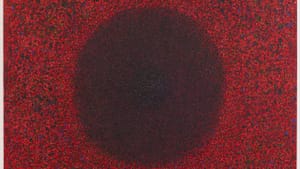Stay in the Loop
BSR publishes on a weekly schedule, with an email newsletter every Wednesday and Thursday morning. There’s no paywall, and subscribing is always free.
A thousand points of light
Richard Pousette-Dart in New York

Richard Pousette-Dart, the 20th-century American abstractionist, lived a life largely under the radar after moving from New York City to upstate Rockland County in 1951. Moving wasn’t an option: The building he lived in was being demolished. Moving away from the high-pressure, high-stakes world of New York art politics, though, was a definite choice. Others of his generation did so, too — Jackson Pollock and Willem de Kooning to the Hamptons, Philip Guston to Woodstock — but not before their reputations had been securely established in the postwar acclaim for Abstract Expressionism and the soaring art market it produced.
Pousette-Dart had received significant recognition in the 1940s for his densely layered and brilliantly colored compositions, but his palette grew increasingly subdued in the next decade, and he gradually evolved a style that seemed as far removed from its pictographic origins as possible. By the mid-1970s, he was producing large, deceptively simple-looking canvases, often dominated by a geometric grid superimposed on a basic color field comprised of innumerable pointillistic strokes and dots. These works were highly textured, with up to 20 or 30 individual layers of paint, but their overall impression was one of tightly harmonized pattern.
A strong sample of these works has been on display at New York’s Pace Gallery in Chelsea. Since a large show of Pousette-Dart’s drawings was mounted this past fall at the Philadelphia Museum of Art, while another one focused on his photography was being exhibited in Utica, New York, what amounts to a comprehensive if not complete survey of his art has been on view. It’s the Pace show, though, despite its relatively small scale — 22 paintings and drawings in all, produced between 1969 and 1986 — that’s the stunner. As you walk deeper into it, you enter a force field in which the most simple-seeming elements radiate a luminescent energy that draws you ever deeper toward a sense of primal origin.
The viewer and the viewed
The simplicity of design in these works masks a complexity not only of composition but also of rendering. They are cosmographies — the most immediate sense is of vistas opened up by the framing device of superimposed circles, rectangles, and, in one work simply entitled Mirror of Space, a square. But the status of these figurations is ambiguous, much like mirrors themselves — objects at a distance that provide us with the sole reflection of ourselves.
If the “mirrors” in Pousette-Dart seem to face out on deep space in the manner of an astronomical lens, the two-dimensionality of their forms suggests a suspension in which space flows both ways, both from and toward us — in short, a continuum in which we ourselves are contained. Here, Pousette-Dart exploits the very limitation of his canvas to suggest the most encompassing kind of space, in which both viewer and viewed are contained in an inseparable unity.
Looking at these works, each a distinct variation on the others, a famous photograph by Lee Miller came to mind, in which a desert landscape is seen through the frame of a broken window screen. It’s an unprovable hunch, but Pousette-Dart, who was much engaged with photography in his youth, might well have seen that picture, and processed it for future reference. Miller’s image plainly implies not only the camera lens but also the seeing eye and framing intelligence behind it. Pousette-Dart’s grids seem at once farther from and closer to the viewer, so that we realize that our attempt to “locate” them on the picture plane is a vain attempt to spatialize them: They are both here and there for us, the seer and the seen in a single manifold.
Child’s wonder
The difficult achievement of 20th-century art was the renunciation of perspectival illusion, which allowed us to construe depth on the canvas in a manner that corresponded to our perceptual habit of differentiating objects by distancing them in a spatial field. Modern relativity has revealed this as a trick we play on ourselves; Pousette-Dart both tempts us with this vision and rejects it, the better to tease us into the comprehension of simultaneity.
Pousette-Dart himself gives us the key to his project in these works with his remark that “all form is made up of many points of light and that everything has a molecular structure.” We perceive light as a unitary phenomenon, understanding color as a consequence of refraction. But light as such is a product of the propulsive, self-consuming energy of stars and the countless micro-events that stellar process consists of; if it is life, at least on this planet, but it is also mortality itself. Pousette-Dart’s pointillism is an effort to express this complex signification, which begins in the sun’s core and ends in the retina — or, perhaps, at the tip of the artist’s brush.
What he captures, then, is both radiance as process and the perceptual frame of our seeing, which is also, through geometrical form, what we ourselves add to the world. The result is canvases charged with their own energy, but at the same time curiously reposeful: not the churchy effect you can get with Rothko (who is often seen to best advantage in subdued light), but the candid wonder before a night sky that can sometimes bring us back to our first childhood experiences.
Cosmology and optics
Pousette-Dart, though, is neither naïve nor didactic; each canvas is approached as a separate event, and his style would continue to evolve (while sometimes doubling back on itself) to the end of his life. Like his contemporaries Jon Schueler and Robert Richenburg, Pousette-Dart fused abstraction with meticulous observation. His importance, like theirs, will I think grow. I think, too, that we will see and value him as an heir of the luminist tradition of the 19th century as well as a painter occupied by the modern intersection of cosmology and optics.
If all this sounds too serious, let me say that, in their bracing austerity and painterly richness, these works are a sheer delight.
What, When, Where
Richard Pousette-Dart. Through February 14, 2015 at Pace Gallery, 510 West 25th St., New York. 212-255-4044 or www.pacegallery.com.
Sign up for our newsletter
All of the week's new articles, all in one place. Sign up for the free weekly BSR newsletters, and don't miss a conversation.

 Robert Zaller
Robert Zaller